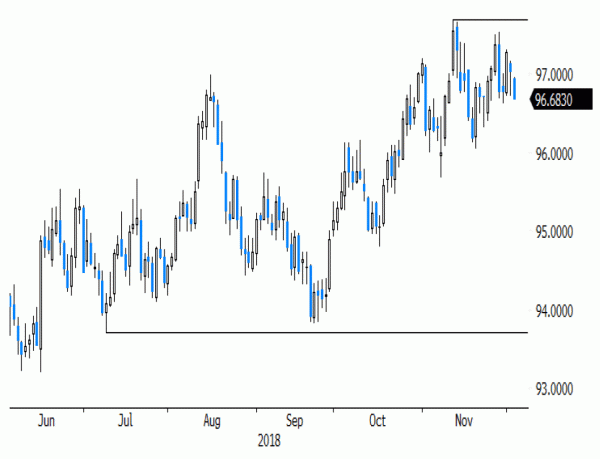Rates: US yield curve sends worrying signal
The US 2yr-5yr and 3yr-5yr yield spreads turned negative for the first time since 2007 with the US 2yr-10yr yield spread setting a new cycle low at 13 bps. The flattening of the curve suggests markets start discounting a turn in the US rate cycle somewhere around 2021. The US 10-yr yield’s break below key support suggests a retracement towards 2.8%.
Currencies: dollar struggles as US yields decline further
Yesterday’s risk rebound failed to give clear directional guidance for USD trading. At the end of the day, the dollar lost only marginal ground. The move continues this morning. A risk-off sentiment doesn’t help the dollar and is counterbalanced by a further decline in US yields. For now, USD weakness prevails despite diffuse signals on global markets
The Sunrise Headlines
- US stock markets opened stronger (>+1%) on the Xi-Trump outcome, but traded sideways afterwards. Asian equities show a reversal of risk sentiment with Japan heavily underperforming, losing over 2%.
- France and Germany renounce EU plans to impose a wider-ranging digital tax on tech companies. Instead both countries agreed to compromise to only tax the European advertising revenues of digital companies at 3%.
- The Reserve Bank of Australia left its policy rate unchanged at a record low of 1.50%. Low income growth and high household debt are reason for caution amid economic strength. Inflation is expected to creep towards target.
- Iranian OPEC Governor Hossein Kazempour Ardebili said that oil prices would further fall unless OPEC and its allies cut output significantly. He added production will need to be reduced by at least 1.4m b/d to prevent oversupply.
- China’s central bank Governor Yi Gang said the bank will keep monetary policy flexible and adjust it appropriately according to changes in China’s economic situation. China’s economic growth has cooled to the weakest pace since 2008.
- US President Trump appoints Trade Representative Robert Lighthizer to lead the negotiations in the China trade talks. Lighthizer is known as a hard-liner and a long-time China trade critic, proving the US will pursue a tough stance.
- Today’s economic calendar contains the Markit/CIPS construction PMI in the UK and the producer inflation for the EMU. BoE Governor Carney defends Brexit scenario’s in Parliament, while Fed’s Williams holds a press briefing
Currencies: Dollar Struggles As US Yields Decline Further
USD in the defensive as global sentiment wobbles
The risk rally in the wake of the US-China trade truce turned out a bit different across markets yesterday. Equities showed good gains, but, the reaction of core bonds and of the dollar was less straightforward. A rise in US and German yields was soon reversed. EUR/USD, a traditional beneficiary of a risk-rally, also opened stronger but couldn’t maintain the early gain and entered an erratic-like trading pattern. The pair closed the day at 1.1354 with no clear directional trend. USD/JPY also showed an indecisive pattern to finish the day at 113.66. EMU data (PMI’s) and the US manufacturing ISM were not too bad or even stronger than expected (ISM), but were no lasting support for yields or the dollar. Overnight, the positive sentiment ebbed further. Asian indices show modest losses with Japan underperforming (-2.0% +). Remarkably, the dollar fails to profit from the risk-off. A decline in US yields (and narrowing of USGerman interest rate differential at the long end of the curve) might be part of the explanation. The further rise of the yuan is alos striking. The dollar is also losing ground against the yen (USD/JPY low 113 area) and against the euro (EUR/USD 1.1375). The Reserve bank of Australia left its policy rate/policy assessment unchanged. AUD/USD is holding in the 0.7375 area. Today, there no data with market moving potential in the US or in Europe. Fed Williams will hold a press briefing. US equity futures suggest that yesterday’s risk rally might already run into resistance. Markets doubt that the US-China trade truce will be a gamechanger for US/global growth goging forward. At least for now, the decline in core yields is weighing more on the dollar and on the likes of the euro and/or the yen. We are not convinced that this trading pattern should last. However, for now, USD sentiment looks fragile. We started the week with a cautious positive EUR/USD. This trend apparently continues today, but we are puzzled on the drivers of the move. For now, we assume the 1.15/1.1621 range top wil hold short-term.
EUR/GBP again developed an erratic like intraday trading pattern. The UK manufacturing PMI was stronger than expected at 53.1, but didn’t help sterling. Persistent political uncertainty ahead of the key Brexit vote next week kept sterling in the defensive. Today, the (potentially tumultuous) debate in parliament will continue. We see no trigger for uncertainty on sterling to easy anytime soon. We continue to avoid sterling long exposure
USD (trade-weighted DXY): dollar struggles as sentiment on risk falters and US yields decline













